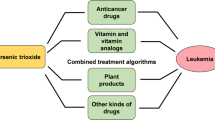Abstract.
In this paper the use of arsenic compounds as anticancer agents in clinical trials and in in vitro investigations is reviewed, including the experience at our institute. Treatment of newly diagnosed and relapsed patients with acute promyelocytic leukemia (APL) with arsenic trioxide (As2O3) has been found to result in complete remission (CR) rates of 85–93% when given by intravenous infusion for 2–3 h at a dose of 10 mg/day diluted in 5% glucose saline solution. Patients exhibit a response in 28–42 days. CR rates after administration of Composite Indigo Naturalis tablets containing arsenic sulfide and of pure tetraarsenic tetrasulfide reached 98% and 84.9%, respectively. At higher concentrations (1–2 µM), arsenic induced apoptosis, while at lower concentrations (0.1–0.5 µM), it triggered cell differentiation in vitro. As2O3-induced apoptosis has been observed in many cancer cell lines, including esophageal carcinoma, gastric cancer, neuroblastoma, lymphoid malignancies, and multiple myeloma. Its effectiveness was confirmed in the treatment of multiple myeloma. Arsenic compounds are effective agents in the treatment of APL and their activity against other types of cancer requires further investigation.
Similar content being viewed by others
Author information
Authors and Affiliations
Additional information
Electronic Publication
Rights and permissions
About this article
Cite this article
Wang, ZY. Arsenic compounds as anticancer agents. Cancer Chemother Pharmacol 48 (Suppl 1), S72–S76 (2001). https://doi.org/10.1007/s002800100309
Issue Date:
DOI: https://doi.org/10.1007/s002800100309




